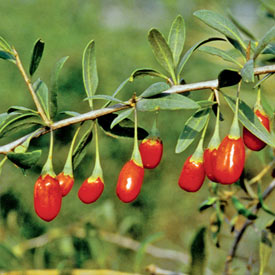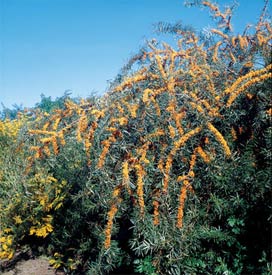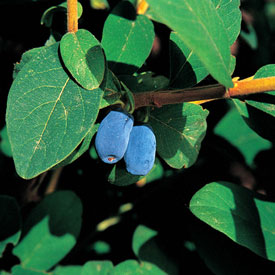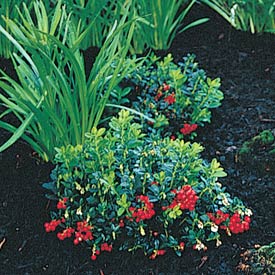
Goji berries are the latest health craze to sweep the nation. The easy-to-grow plants produce orange berries loaded with protein, vitamin C, iron, and beta-carotene. Plus, they taste good.
By September most of the common berry fruits have finished their production (though you you may continue to harvest a few everbearing strawberries and raspberries). Tree fruits, such as apples and pears, dominate the fall fruit harvest. However, don't put berries out of your mind just yet. Fall is a good time to do a little research and plant some unusual berry crops for next year.
There is more to berry gardening than planting the usual strawberries, raspberries, blueberries, and grapes. Although I love growing all of these, it's the unusual fruits that get my attention. I'm not going to rip out my hedge of raspberries or my blueberry shrubs and replace them with goji berries or sea buckthorns, but there are spots in the yard where I may try a few berries of a different shape and color. Plus, many of these unusual berry shrubs are attractive ornamentals, so you get the benefit of beautiful landscape shrubs with something to eat as well.
Here is a sample of eight unusual berry shrubs to try. Check out the mail-order companies below for sources. Good luck on your berry exploration!
Aronia (Aronia melanocarpa)
Sea berries are large, rangy shrubs that produce an abundance of orange fruits that make a nutritious and tasty juice.
Aronia, also called black chokecherry, is an extremely hardy shrub that can be grown in USDA hardiness zones 3 to 8. It grows 3 to 6 feet tall and wide, depending on the variety. This vigorous shrub is self-fertile, generally insect- and disease-free, and produces an abundance of blue-black berries in summer. The berries make a strong-flavored wine, juice, or jam, and have one of the highest levels of antioxidants of all the berry crops. 'Viking' and 'Nero' are two good selections.
As an added benefit, the glossy green leaves of this deciduous shrub turn fire engine red in fall. Instead of planting burning bush, why not grow aronia for fall color and edible berries? The plants sucker freely and can be used as a hedge plant along a wall or building.
Chilean guava (Ugni molinae)This Chilean native shrub grows about 3 to 6 feet tall at maturity. It's a slow-growing evergreen that is hardy only to 18 degrees F, making it suitable for edible gardens in USDA hardiness zones 9 and 10. However, it makes a great container plant and can be brought indoors for the winter in colder areas. Chilean guava produces small, fragrant, white flowers in spring and summer. The purple-red, blueberry-sized fruits have a mildly spicy, guava-like flavor and can be eaten fresh or made into jams and jellies. Chilean guava grows best in full to part sun on well-drained soils. It makes a great foundation shrub or focal point in a perennial flower border.
Goji Berry (Lycium barbarum)Every few years a plant rocks the edible plant world, and for the last few years it's been the goji berry. This deciduous, 10-to-12-foot-tall, rangy shrub is native to Tibet and the Himalayan mountains and bears raisin-sized berries from summer until fall. The berries are reported to contain 13 percent protein and are loaded with antioxidants. They also contain more iron than spinach, more vitamin C than oranges, and more beta-carotene than carrots. Goji berries are used in Tibet to treat a variety of ailments and to increase longevity.
Goji berries are hardy in USDA zones 5 to 9 and readily adapt to most soils. In spring, the attractive white and purple flowers form. By late summer, fresh, juicy, and sweet orange-red goji berries begin to ripen. Since the plant forms such as rangy shrub, goji berries don't fit well in a formal garden and are best grown on their own as a hedge or a mass planting.

Honeyberry is related to honeysuckle. These sweet fruits are produced on shrubs that grow well in moist and partly shady locations.
This Far East native is a deciduous shrub hardy in USDA zones 4 to 8. The plants grow to 6 feet tall and wide. The backs of the leaves are an attractive silver-green, contrasting with the darker green upper surfaces. The fragrant flowers bloom in spring and are a favorite of bees. The abundant cherry-sized tart red fruits ripen in summer. Although they can be eaten fresh, they are mostly used to make pies and sauces.
This relative of autumn olive is a nitrogen-fixing shrub and so is a good choice on poorer soils, as long as it gets full sun. It's best to plant at least two varieties since they are only partially self-fertile.
Honeyberry (Lonicera caerulea)This honeysuckle relative produces sweet, 1- to 2-inch-long, blueberry-like fruits that can be eaten fresh or made into pies and sauces. The shrub grows 4 to 5 feet tall and wide, is generally disease- and insect-free, and is extremely cold hardy (USDA zones 3 to 8). Honeyberry grows best in moist, shady soils, making it a good choice in difficult landscapes. Plant at least two different varieties for good cross-pollination. Since the plants bloom and fruit early in the season (sometimes before strawberries), gardeners in cold areas should protect the shrubs from late spring frosts.
Jostaberry (Ribes nidigrolaria)This shrub is a cross between black currant and gooseberry. Jostaberry looks like a gooseberry, but the plant has no thorns and the fruit is sweeter. It has the vigorous growth and disease resistance of a black currant, and the 1/2-inch-diameter black fruits are loaded with vitamin C. A mature, 6-foot-tall and wide deciduous shrub can produce up to 12 pounds of fruit. The berries have a flavor similar to grape, kiwi, and blueberry. Plants are hardy in USDA zones 3 to 8, and are widely adapted. The beautiful bushes make excellent foundation plants.

Lingonberry is an evergreen ground cover that grows well in moist, acidic soils. The berries are great in jams and preserves.
This small, evergreen shrub grows to a height of about 1 foot, making it a good ground cover. The bright red berries of this blueberry relative are popular in Scandinavia for making jams and juice. The plants flower twice a year and produce berries in mid summer and fall. They are self-fertile. Like blueberries, they grow best in an acidic soil and full sun. In hot areas they require dappled afternoon light. They can slowly spread by their roots and need an evenly moist soil. Plant them in the front of a low border or in a rock garden. Planting in groups produces the most attractive ornamental effect.
Seaberry (Hippophae rhamnoides)This Russian native is a great conservation plant. It fixes nitrogen and grows on a wide variety of poor soils. It's hardy to USDA zones 3 to 7 and produces berries that birds and humans can enjoy. Seaberry fruits have seven times the vitamin C as lemons and have been used as an orange juice substitute in many countries. In Europe you'll find seaberry juice in grocery stores.
The rangy, deciduous shrub grows 6 to 18 feet tall at maturity. Some varieties, such as 'Amber Dawn', stay relatively small. There are male and female shrubs, so select least one of each. The plant is salt-and drought-tolerant and prefers full sun. The attractive, narrow, gray-green leaves make this shrub excellent for hedges. In fall, clusters of currant-sized, orange berries appear; the berries persist through winter, attracting wildlife. Mature plants can produce 50 pounds fruit.
More Great Stories on unusual berries:Some good sources of these berry shrubs:Photos courtesy of One Green World
 Charlie Nardozzi is an award winning, nationally recognized garden writer, speaker, radio, and television personality. He has worked for more than 30 years bringing expert gardening information to home gardeners through radio, television, talks, tours, on-line, and the printed page. Charlie delights in making gardening information simple, easy, fun and accessible to everyone. He's the author of 6 books, has three radio shows in New England and a TV show. He leads Garden Tours around the world and consults with organizations and companies about gardening programs. See more about him at Gardening With Charlie.
Charlie Nardozzi is an award winning, nationally recognized garden writer, speaker, radio, and television personality. He has worked for more than 30 years bringing expert gardening information to home gardeners through radio, television, talks, tours, on-line, and the printed page. Charlie delights in making gardening information simple, easy, fun and accessible to everyone. He's the author of 6 books, has three radio shows in New England and a TV show. He leads Garden Tours around the world and consults with organizations and companies about gardening programs. See more about him at Gardening With Charlie.
 Victory Seed Company has all the seeds you want for your best garden in 2024.
Victory Seed Company has all the seeds you want for your best garden in 2024.
For 25 years, the family-owned Victory Seed Company has provided the highest quality vegetable, herb and flower seeds to families across the country. We are passionate about providing you the best seeds available that give excellent germination, robust plants, and the harvest you want. With a catalog of over a thousand varieties, we have everything, and our prices are the kinds that we'd want to pay. We have hundreds of yesterday's heirloom vegetables, as well as today's award winning hybrid selections. Get to know us by visiting our website and browsing through our online vegetable seed catalog.